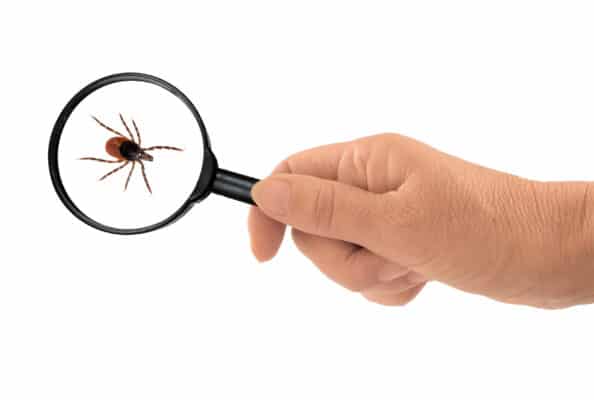
Now that it’s starting to stay warmer, you, your family, and your pets might be spending more time outside. Whether you’re hiking, biking, or just chilling in your yard, it’s always a good idea to check both humans and pets for ticks before you go inside. So what should you do if you’ve spotted one?
Step 1: Remove the Tick from Your Skin
If you’ve only just found the tick and it hasn’t had the time to bite you and start sucking your blood, remove it from your body, Do not use your bare hands- use gloves, tweezers, or a tissue to remove it.
If the tick has already attached, it’s important to remove it entirely. The Centers for Disease Control (CDC) has some tips on how to get ticks off you as quickly and safely as possible:
- Use fine-tipped tweezers to grasp the tick as close to the skin’s surface as possible.
- Pull upward with steady, even pressure. Don’t twist or jerk the tick; this can cause the mouth-parts to break off and remain in the skin. If this happens, remove the mouth-parts with tweezers. If you are unable to remove the mouth easily with clean tweezers, leave it alone and let the skin heal.
- Dispose of a live tick by submersing it in alcohol, placing it in a sealed bag/container, wrapping it tightly in tape, or flushing it down the toilet. Never crush a tick with your fingers.
- If you fear that you’ve been bitten a tick that is carrying a virus or a disease, you can send it to a lab for further testing.
Ready for the protection of Homecare Mosquito, Flea, and Tick? Click here or call 1-800-323-7378 now!
Step 2: Clean the Tick Location
Clean the area where the tick was crawling where it bit you with soap and water. Follow up by scrubbing the area/s with iodine or a little rubbing alcohol. It is important to disinfect the area immediately in case the tick was a disease carrier.
Step 3: Tick Identification
Some ticks carry infectious diseases. Black-legged, or deer, ticks can transmit Lyme disease. American dog ticks can carry Rocky Mountain Spotted Fever. And lone star ticks can give humans an allergy to red meat, just to name a few.
Apart from saving the bug for lab testing, you can use Modern Pest’s Pest Library to identify ticks. Just click here.
Step 4: Look at the Area of the Tick Bite
After sanitizing the area of the tick bite, look at your skin closely. If you notice any signs of redness, a rash, or swelling, you’ll need to consult a doctor.
Step 5: Visit a Doctor if There Are Visible Signs
If you’ve developed a rash, this may be a sign of a tissue infection or even Lyme disease, and your doctor will likely provide you with a prescription for antibiotics. The doctor will most likely need the following information from you:
- What your physical symptoms are
- How long ago you were bitten
- Where you were bitten (physical location)- this is important to see if the area is known for tick-related diseases like Lyme disease, or not
- If you’re on any strong medication that can lower your immunity like chemotherapy
- If you have any medical conditions that make you more susceptible to illnesses, such as diabetes
Step 6: Take Precautions
It’s important to take safety precautions year-round when the weather warms up and you’re in areas where ticks live, such as wooded or grassy areas and leaf piles.
- Wear long pants and long sleeves and tuck your pantlegs into your socks.
- Use bug repellents containing DEET, picaridin, or oil of lemon eucalyptus.
- Treat clothing with permethrin to kill ticks, but keep in mind it’s harmful to cats.
- Always shower and do a thorough tick check on yourself, children, and pets when returning indoors.
Schedule your Homecare Mosquito, Flea, and Tick service now! Just call 1-800-323-7378 or click here
The Final Step: Professional Tick Control
Modern’s Homecare Mosquito, Flea, and Tick service protects against all three disease-spreading vector pests. We’ll help you enjoy your yard while we minimize the health risks to your family and pets. The service consists of six monthly services, from April through September. Call 1-800-323-7378 to schedule service.
The CDC suggests that you don’t employ any tick folk remedies. You don’t want to wait for the tick to detach, you want to remove it quickly.
- Don’t paint the tick with nail polish, or cover it in petroleum jelly.
- Don’t stick a hot match or any other heat source on it.
- If you develop a fever, rash, or aches and pains within several weeks of being bitten, tell you doctor about the tick bite
- You want to spend your summer enjoying the outdoors, not inside with Lyme disease or Rocky Mountain spotted fever.
